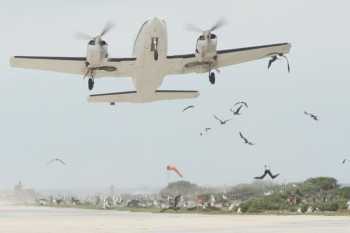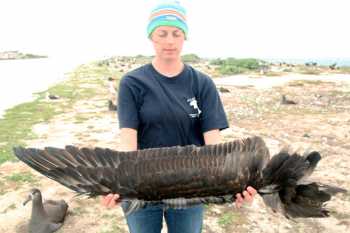"Effectively tracking Monument permits allows for accurate reporting of levels of human presence. The level of human presence in the Monument is strictly regulated and continually evaluated to monitor and mitigate for cumulative impacts. Human presence in the Monument is necessary to carry out resource management objectives and conduct necessary scientific and cultural research. The number of permitted aircraft and vessel entries into the Monument is one method of measuring the level of human presence. Midway Atoll National Wildlife Refuge operates a small functioning airport, and Tern Island within French Frigate Shoals contains a small airstrip. These two areas within Papahänaumokuäkea are the only locations equipped to accept aircraft. Table 1 indicates the number of permitted flights that occurred to and from the Monument in 2008-2010. Within the past two years (2009-2010), there was a 28 percent decrease in the total number flights in the Monument."
Table 1. The number of flights permitted to and from the Monument, in 2008 through 2010
|
Airport/Airstrip Location |
2008 |
2009 |
2010 |
|
French Frigate Shoals |
13 |
13 |
11 |
|
Midway Atoll |
99 |
87 |
61 |
Taken from "Papahānaumokuākea Marine National Monument permitted Activities 2010 Annual Report" at http://www.papahanaumokuakea.gov/resource/support/2010PermitAR_web.pdf.
Collisions between birds and fixed- and rotary-wing aircraft are a serious problem world-wide. However, ACAP-listed species by the nature of them breeding on mainly uninhabited islands distant from airports would seem to be not overly at risk from this form of mortality (but click here for the previous news story in ACAP Latest News on the bird-strike problem affecting Laysan Albatrosses P. immutabilis).
On 25 January 2008 on USA's Tern Island, French Frigate Shoals in the North Pacific a small fixed-wing aeroplane killed three Endangered Black-footed Albatrosses Phoebastria nigripes on take-off. One bird was sliced in half and two died of internal injuries. The plane was an eight-seater, two-engined Cessna 421C.


It has been reported that other take-offs by planes from Tern Island have resulted in avian mortalities, on one at least occasion killing up to an estimated 70 Sooty Terns Sterna fuscata.
Tern Island has a landing strip and permanent habitation for a small number of people. It is maintained as a field station in the Hawaiian Islands National Wildlife Refuge by the United States Fish and Wildlife Service as part of the Papahānaumokuākea Marine National Monument.
Go to http://ruthontern.blogspot.com/2010/05/written-tuesday-23rd-february-plane-day.html to read of the current efforts being made to reduce bird strikes on Tern Island by scaring ("hazing") birds off the runway (which occupies much the larger part of the island) before each flight. A plane flies between Honolulu, Ohau and Tern Island about once a month. It shuttles scientists to and from the island, carries mail and occasionally brings groceries.
The management plan for the Papahānaumokuākea Marine National Monument has a section (3.3.3 Maritime Transportation and Aviation Action Plan; pp. 217-222) that states " A relatively small number of flights are conducted in the Monument. The ... agencies charter on average 27 flights to French Frigate Shoals and 45 flights to Midway Atoll each year to transport supplies and personnel. The Coast Guard conducts regular enforcement overflights, often landing at Midway Atoll for refueling." Strategies have been identified for achieving the desired outcome of preventing and reducing impacts of aircraft operating in and transiting the monument.
ACAP Latest News would be pleased to hear of other occurrences of bird strikes of ACAP-listed species for posting to this web site.
With thanks to Ian Jones for information.
John Cooper, ACAP Information Officer, 26 August 2011, updated 1 September 2011

 English
English  Français
Français  Español
Español